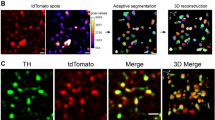Summary
Dopamine released from dendrites of nigrostriatal neurones in the substantia nigra exerts an inhibitory action on these cells. However, the spatio-temporal characteristics of the action of dendritic dopamine is still unclear. The aim of the present study was to investigate the responses of these neurones in the guinea-pig to amphetamine, applied locally in the region of the distal dendrites in pars reticulata. During intracellular recording in vitro it was found that amphetamine hyperpolarizes the membrane and causes a decrease in the input resistance, probably by increasing a potassium conductance. This response was resistant to blockade of sodium channels but sensitive to dopamine depletion by reserpine and alpha-methyl-p-tyrosine. The response showed tachyphylaxis and proved to be highly dependent on the site of administration of amphetamine. It is concluded that the release and action of dopamine occurs locally, in a heterogenous pattern, within the dendritic field of nigrostriatal neurones. The possibility is discussed that this phenomenon underlies a modulatory mechanism, localized in dendrites.
Similar content being viewed by others
References
Andersen P, Bie B, Ganes T (1982) Distribution of GABA sensitive areas on hippocampal pyramidal cells. Exp Brain Res 45: 357–363
Bunney BS, Aghajanian GK (1973) Electrophysiological effects of amphetamine on dopaminergic neurons. In: Usdin E, Snyder SH (eds) Frontiers in catecholamine research. Pergamon Press, Oxford, pp 957–962
Bunney BS, Aghajanian GK, Roth RH (1973) Comparison of effects of L-dopa, amphetamine and apomorphine on firing rate of rat dopaminergic neurones. Nature New Biol 245: 123–125
Butcher LL, Woolf NJ (1982) Monoaminergic-cholinergic relationship in the chemical communication matrix of the substantia nigra and neostriatum. Brain Res Bull 9: 475–492
Cheramy A, Leviel V, Glowinsky J (1981) Dendritic release of dopamine in the substantia nigra. Nature 289: 537–542
Cuello AC, Iversen LL (1978) Interactions of dopamine with other neurotransmitters in the rat substantia nigra: a possible functional role of dendritic dopamine. In: Garattini S, Pujol JF, Samanin R (eds) Interactions between putative neurotransmitters in the brain. Raven Press, New York, pp 127–149
Fadda F, Argiolas A, Stefanini E, Gessa GL (1977) Differential effect of psychotropic drugs on dihydroxyphenylacetic acid (DOPAC) in the rat substantia nigra and caudate nucleus. Life Sci 21: 411–418
Geffen LB, Jessel TM, Cuello AC, Iversen LL (1976) Dopamine release in substantia nigra. Nature 260: 257–260
Grace AA, Bunney BS (1983) Intracellular and extracellular electrophysiology of nigral dopaminergic neurons. 1. Identification and characterization. Neuroscience 10: 301–315
Greenfield SA (1985) The significance of dendritic release of transmitter and protein in the substantia nigra. Neurochem Int 7: 887–901
Groves PM, Wilson CJ, Young SJ, Rebec GV (1975) Selfinhibition by dopaminergic neurons. Science 190: 522–529
Juraska JM, Wilson CJ, Groves PM (1977) The substantia nigra of the rat: a Golgi study. J Comp Neurol 172: 585–600
Kita T, Kita H, Kitai ST (1986) Electrical membrane properties of rat substantia nigra compacta neurons in an in vitro slice preparation. Brain Res 372: 21–30
Lacey MG, Mercuri NB, North RA (1986) Dopamine hyperpolarizes neurones in the rat substantia nigra zona compacta in vitro by increasing potassium conductance. J Physiol 381: 51P
Leviel V, Cheramy A, Glowinsky J (1979) Role of the dendritic release of dopamine in the reciprocal control of the two nigrostriatal dopaminergic pathways. Nature 280: 236–239
Llinás R, Greenfield SA, Jahnsen H (1984) Electrophysiology of pars compacta cells in the in vitro substantia nigra — a possible mechanism for dendritic release. Brain Res 294: 127–132
Llinás R, Sugimori M (1980) Electrophysiological properties of in vitro Purkinje cell somata in mammalian cerebellar slices. J Physiol 305: 171–195
Myers RD, Hoch DB (1978) 14C-dopamine microinjected into the brain-stem of the rat: dispersion kinetics, site content and functional dose. Brain Res Bull 3: 601–609
Nieoullon A, Cheramy A, Glowinsky J (1977) Release of dopamine in vivo from cat substantia nigra. Nature 266: 375–377
Nieoullon A, Cheramy A, Leviel V, Glowinsky J (1979) Effects of the unilateral nigral application of dopaminergic drugs on the in vivo release of dopamine in the two caudate nuclei of the cat. Eur J Pharmacol 53: 289–296
Paden C, Wilson GJ, Groves PM (1976) Amphetamine-induced release of dopamine from the substantia nigra in vitro. Life Sci 19: 1499–1506
Pinnock RD (1983) Sensitivity of compacta neurones in the rat substantia nigra slice to dopamine agonists. Eur J Pharmacol 96: 269–276
Walters JR, Roth RH, Aghajanian GK (1973) Dopaminergic neurons: similar biochemical and histochemical effects of hydroxybutyrate and acute lesions of the nigro-neostriatal pathway. J Pharmacol Exp Ther 186: 630–639
Waszczak BL, Walters JR (1986) Endogenous dopamine can modulate inhibition of substantia nigra pars reticulata neurons elicited by GABA iontophoresis or striatal stimulation. J Neurosci 6: 120–126
Author information
Authors and Affiliations
Rights and permissions
About this article
Cite this article
Nedergaard, S., Hopkins, C. & Greenfield, S.A. Do nigro-striatal neurones possess a discrete dendritic modulatory mechanism? Electrophysiological evidence from the actions of amphetamine in brain slices. Exp Brain Res 69, 444–448 (1988). https://doi.org/10.1007/BF00247591
Received:
Accepted:
Issue Date:
DOI: https://doi.org/10.1007/BF00247591




